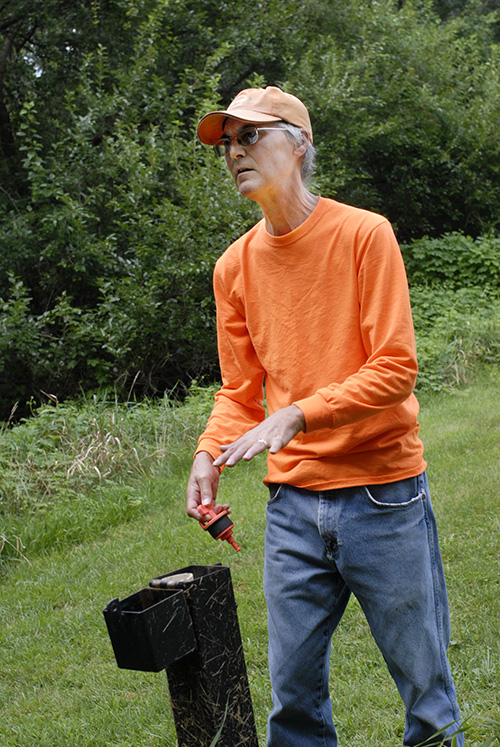
Charles Hostetler, a hydrologist with Peoria Disposal Company, is checking a monitoring device installed at Vicary Bottoms Dog Park on Kickapoo Creek Road that measures levels of ground water. The measurements are important to the work Hostetler is doing designing the conversion of the expansive mowed field at the dog park into a wetland filled with native vegetation and surrounded by a hiking trail. (PHOTO BY CLARE HOWARD)
He hopes to make the correlation universally clear with a project along Kickapoo Creek Road.
A hydrologist with the Peoria Disposal Company, Hostetler has worked on a design that will transform Vicary Bottoms Dog Park into a wetland and hiking trail.
The project is planned to earn wetland mitigation bank credits to allow PDC to develop its landfill No. 3 site that covers an ephemeral wetland. Under the Clean Water Act, any development that destroys a wetland must be balanced by creation of a corresponding wetland within the same floodplain with compensating environmental benefits.
“I believe major change is coming to how Central Illinois looks at development,” Hostetler said.
Wetland mitigation used to be a haphazard process with concrete rip rap dumped around the edges of a retaining pool. Now both the U.S. Army Corps of Engineers and Illinois Department of Natural Resources must signoff on these mitigation projects.
Hostetler worked for 25 years on projects out west before returning to the Peoria area four years ago. He said mitigation banking was easier to do in the west but the concept is gaining ground in the Midwest.
“In the 1960s, people used the banks of Kickapoo Creek as a dump for trash. Now I can see a string of wetlands along Kickapoo Creek,” he said. “A necklace of wetlands. A constellation of these wetlands up and down the creek will enhance the entire ecosystem. There will be a synergy that is not just evaluated by each individual wetland but by a necklace of these sites.”
He thinks his current project could be a model for good wetland mitigation banking.
Wetland restoration is superior to the reactive work of putting up sandbags and levies to contain flooding, Hostetler said.
He expects work on the site along Kickapoo Creek will begin late this year and is projected to cost $1,150,000. Completion is expected by autumn 2019.
“As the creek begins to heal, it will regain its meanders and will cut down on siltation and nitrogen ending up in the Gulf of Mexico,” he said.
He will oversee maintenance of the wetland for its first five years and then maintenance will be assumed by the Peoria Park District.
Hostetler, who has his PhD in chemistry, said Kickapoo Creek is loaded with farm chemicals including phosphate and nitrates and the wetland restoration will help filter out those chemicals.
The restoration will also mean Kickapoo Creek could become more feasible to navigate by kayak or canoe at certain times of the year.
The science of wetland restoration is still evolving. Hostetler has a list of native plants that will be part of the site restoration.
“The plants will have to settle in over several years. Relax into the environment,” he said. “It took nature 10,000 years to build wetlands. Then we started to tear them up about 1910 to 1930. Now we need to reestablish the land’s connection with its past.”
Vicary Bottoms wetland restoration will encompass 10.5 acres and is one of the most complex Hostetler has created. He estimates about 15,000 semitruck loads of soil will be removed so Kickapoo Creek flows into the wetland.
While the Clean Water Act is credited for the current work on wetland restoration, Hostetler said regulations became more expansive and inclusive with changes in what the U.S. Army Corps of Engineers has jurisdiction over. The term “waters of the United States” expanded from major, navigable rivers like the Illinois, Mississippi, Colorado and other major rivers to include creeks like the Kickapoo, ephemeral wetlands and even farm ponds.
“Now we have a more scientific formula to interpret the law,” Hostetler said, explaining that a landfill cannot be built in a floodplain without building credits in a wetland mitigation bank by construction of a corresponding wetland in the same floodplain.
A series of wetlands along Kickapoo Creek will help reduce the “flashiness” of the creek that results when water levels surge and recede quickly. That flashiness results in channelization, steep creek beds and erosion. Surging water causes more deposits in the Gulf of Mexico’s Dead Zone.
“This necklace of wetlands will work in sync to help restore the meanders, slow the water so it soaks into the land and prevent erosion and removal of nutrients,” Hostetler said.
“This process is not static. How we go about wetland restoration will change as the philosophy of development changes and the land ethic evolves.”
Tracy Fox, one of the founders of Friends of Rocky Glen and an area environmentalist, sees multiple benefits in the location of this wetland mitigation project. It was more than five years ago Fox suggested mitigation occur on public land rather than on a site within PDC property that is inaccessible to the public.
The Vicary Bottoms Wetland Restoration will be surrounded with a boardwalk and will provide both recreational and educational opportunities for the public. It is also near Rocky Glen that has regular guided tours.
“I would love it if this becomes part of a necklace of restoration work along the Kickapoo,” Fox said. “We’d have a chain of parks from Wildlife Prairie Park.”
Also looking at this area is Donald Hey, executive director of Wetland Research based in Wadsworth outside of Chicago. Hey is working on gaining support for a massive wetland restoration project spanning up to 1,000 acres in the Kickapoo Creek floodplain. He expects his project would be the largest wetland restoration in the state.
